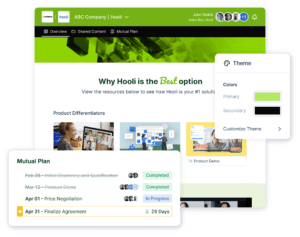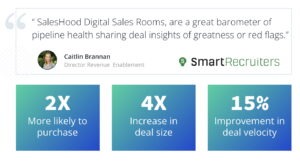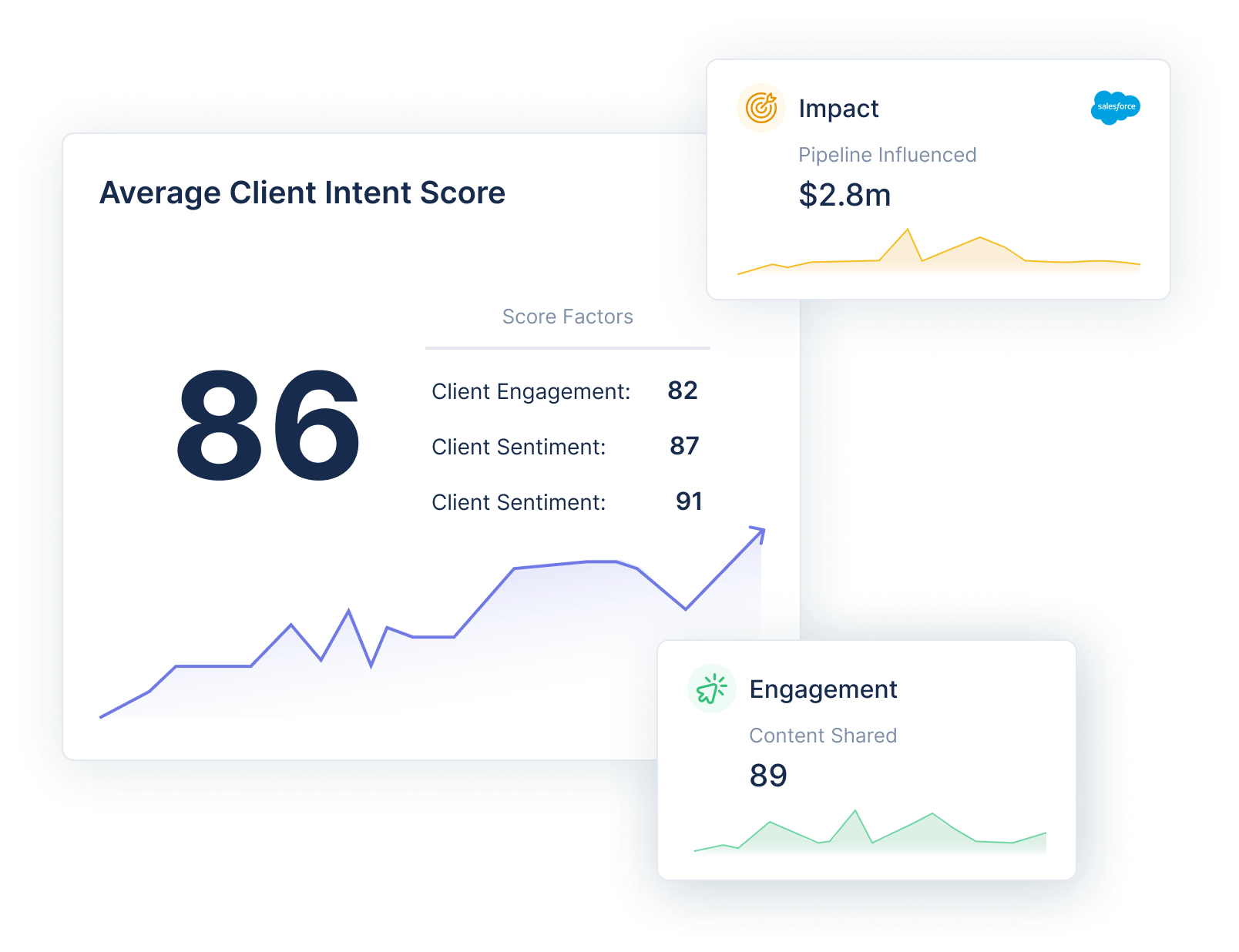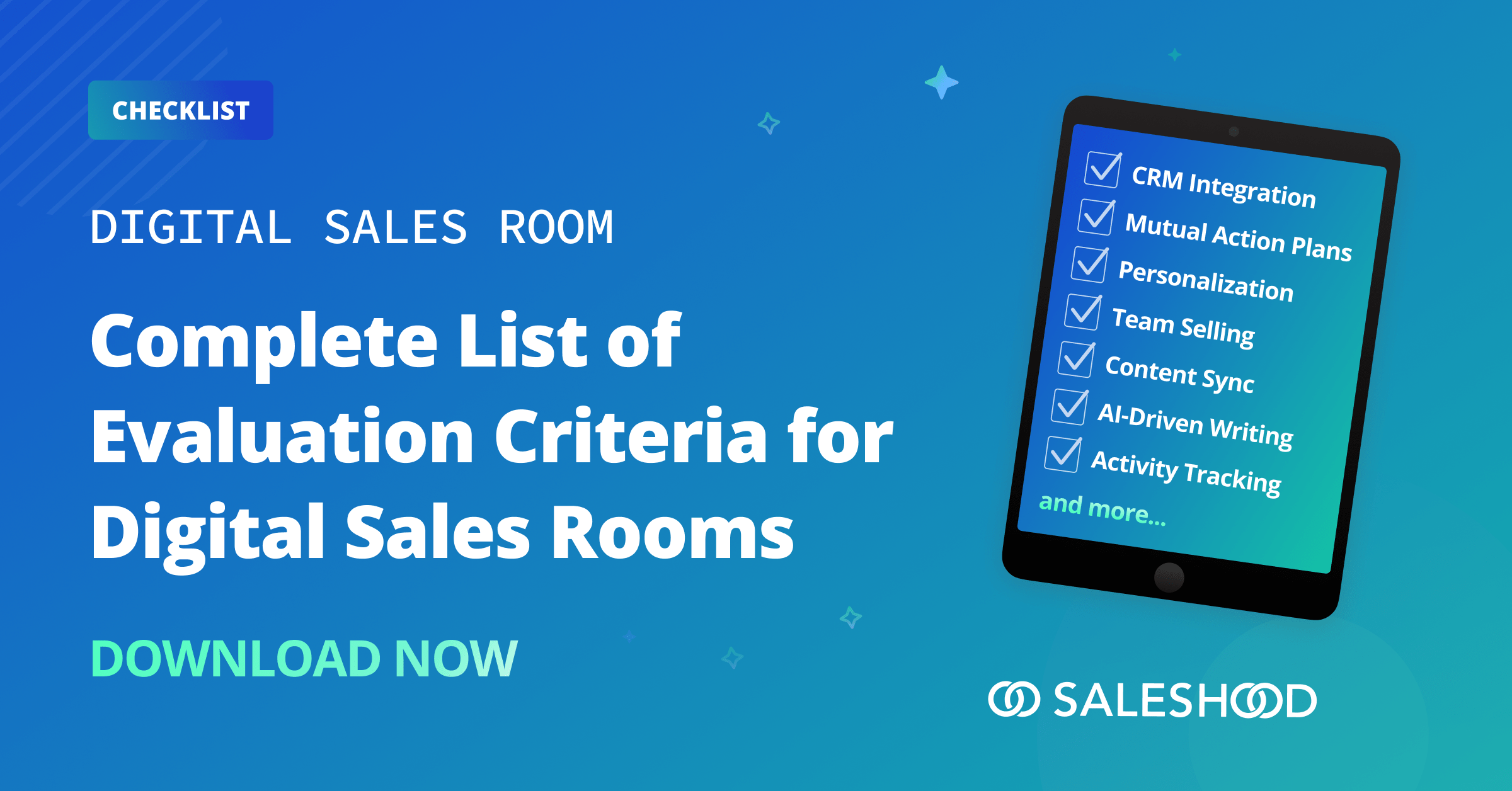Summary: What is a Digital Sales Room (DSR)?
A Digital Sales Room (DSR) is a personalized, digital space where sellers and buyers collaborate, communicate, and co-create throughout the sales process. This blog breaks down how DSRs work, why they’re transforming B2B selling, and how top-performing revenue teams are using them to shorten sales cycles, improve win rates, and create a more engaging buyer experience. Learn best practices for implementation, key features to look for, and how platforms like SalesHood help sellers deliver a modern, buyer-centric experience.
Why Digital Sales Rooms (DSRs) Are Essential in Modern B2B Sales?
B2B buyers today expect more than a pitch—they want a personalized, efficient, and value-driven experience. That’s where Digital Sales Rooms (DSRs) come in.
A DSR is a branded, content-rich online portal that supports every stage of the buying journey by providing a centralized, collaborative space. Also known as virtual sales rooms or buyer engagement portals, DSRs are quickly becoming a must-have in modern sales processes.
Here’s why:
-
Personalized buyer engagement: Share curated content, interactive demos, and relevant messaging tailored to each buyer’s needs.
-
Structured deal progression: Replace scattered email threads and fragmented communications with clear, coordinated touch points.
-
Real-time visibility into buyer behavior: Track engagement, sentiment, and progress—giving reps the data they need to move deals forward.
-
Faster sales cycles: Eliminate delays and back-and-forth by giving buyers everything they need in one place.
-
Increased buyer trust: A consistent, professional experience builds credibility and confidence from the first interaction.
Why Now?
The way B2B buyers make decisions has fundamentally changed:
-
Buyers now complete 27 research sessions on average before speaking to sales (Forrester).
-
Most buyer interactions are self-service—happening through online research, peer reviews, and digital tools.
-
68% of buyers prefer doing their own research over talking to sales (Forrester).
-
The rise of AI, automation, and digital selling has created an expectation for hyper-personalized sales experiences.
Digital Sales Room software helps you meet modern buyers where they are—informed, digital-first, and expecting value at every step. It’s not just a tool; it’s a strategic advantage that improves buyer experience, increases visibility, and drives more predictable revenue.
By the way, there are many different names for Digital Sales Room platform. Use the term that fits best with your industry and buyer expectations.
|
|
|
Digital Sales Room Definition
A Digital Sales Room (DSR) is a personalized and interactive microsite to facilitate and streamline the sales process between buyers and sellers. It’s an all-in-one hub that holds all of the conversations, assets, and other information that has been discussed or provided as part of a deal – from start to finish.
In a typical DSR, the buying party accesses a one-on-one, private sales environment that’s branded and built specifically for them, with added security to keep sensitive information safe. They make it easy for you to create unique, personalized experiences with tailored content and answers to specific questions that improve engagement more than generic marketing or sales copy.
Digital Sales Rooms also have interaction-tracking abilities that let you see who visits the site and what they interact with while there. You can use this information to evaluate deal health based on their engagement and track which pieces of sales enablement content are working and which aren’t to refine your sales strategy.
Prospects can easily access demos, call recordings, pricing data, and other deal-specific information without scouring their email or involving a sales rep, which removes friction from the sales process. They can also revisit the site at any time during the deal cycle to improve their understanding, answer their own questions, compare the competition, and get additional answers to any obstacles that arise.
The Evolution of Selling
Sales is a fluid, ever-changing industry constantly adapting to customers’ needs and expectations. Traditional ‘handshake’ sales strategies are making way for new, modern approaches leveraging technology to help meet prospects where they are and how they want to buy.
For example, Zoom calls replace hard to schedule in-person meetings, interactive websites and guided demos replace static sales brochures and pitches, and Digital Sales Rooms replace inefficient email chains and ‘phone tag.’
Here’s the evolution of selling across the decades with a short video explainer too:
1970s: Traditional sales methods dominated, with a heavy reliance on face-to-face interactions and relationship-building.
1980s: Emergence of consultative selling. Sales began to focus more on understanding customer needs and providing solutions.
1990s – 2000s: The rise of telemarketing and direct marketing. Sales automation and more sophisticated CRM systems became widespread.
2010s: social selling became widespread with platform like Twitter and LinkedIn being used to engage prospects and sell.
2020: Remote selling and virtual interactions became more accepted and expected due to the global pandemic.
Today: Hyper-personalized selling with Generative AI and ChatGPT is accelerating this and compounding all the benefits of the previous years.
5 Ways Digital Sales Rooms Drive Better Results
Digital Sales Rooms empower revenue teams to deliver a modern, personalized, and efficient buying experience—helping sellers wow buyers, improve win rates, accelerate deal cycles, gain deeper buyer insights, and align more effectively with marketing.
Benefit #1: Wow buyers with a better buying experience
Buyers will often revisit content, demos, calls, and other assets you provide during the deal cycle. Email communication can lead to long, hard-to-navigate threads and insecure file attachments, so you need an alternative. A well-organized DSR reduces the back-and-forth, saves time, and equips you and your buyers need to make decisions faster. Your buyers will trust you more than the competition.
A Digital Sales Room holds all of the content in one place. You can organize the assets within tabs for easier navigation and access to conversation histories to avoid miscommunications. Plus, the content can be customized to make it easier to use, like interactive elements or integrated chatting for fast answers to new questions.
Benefit #2: Increase sales efficiency
Many buyers do most of their research and communication online, and 75% of B2B buyers prefer to make purchasing decisions without sales reps. They don’t want to have to wait around for a sales representative to be available to get answers–they want asynchronous sales.
With a self-service resource like a Digital Sales Room, your reps can add any deal-specific content to the DSR so it’s accessible at any time. Prospects can then easily revisit the sales site to compare your answers to the competition or double-check specific information without waiting to hear from a sales rep, improving deal efficiency.
Benefit #3: Improve win rates
According to McKinsey’s research, 76% of buyers get frustrated when their buying experience isn’t personalized. They want to feel like they’re working with a human to find a solution to their problem, not being sold something that won’t work– and personalizing your sales enablement content helps show you’re listening.
With DSRs, you can create unique, personalized experiences with each private site through video replies that answer specific questions, recorded demos that highlight a core feature they need, and more. Plus, you can engage them with stakeholder names, prospect branding, and proposals or solutions built for that client specifically to show they aren’t just a number.
Benefit #4: Shorten sales cycles
Sales cycles are already fast thanks to the speed of information and accessibility of communication. However, a Digital Sales Room can take it to the next level, along with adding benefits that help improve your win rates.
DSRs shorten sales cycles by creating a single contact point to increase communication speed, collecting all sales content in one place to lower information-gathering times for buyers, and providing clear instructions for how to progress deals within the microsite.
Benefit #5: Enhance buyer intent and content intelligence
Historically, the sales cycle has been hard to evaluate. Traditional sales processes can’t give you much insight into your sales performance outside of winning or losing a deal. However, Digital Sales Rooms are controlled environments that can collect and analyze interaction, engagement, and usage information from prospects. You can see who has viewed the microsite, what they’ve clicked on, how long they’ve interacted with a certain piece of content, and other key insights that help you shape future DSRs and sales processes. Watch the video to learn more about buyer engagement data.
Benefit #6: Improve sales and marketing alignment
Inconsistent marketing and sales messaging can be frustrating and alienate potential customers early in the sales process. To avoid this, marketing teams need to ensure they’re creating content that helps sellers sell, and sales teams need to help guide marketing content based on what’s working during sales cycles.
Digital Sales Rooms simplify coordination between sales and marketing teams. Marketing can avoid outdated information by consistently ensuring they’re keeping the content folders that sellers use in their micro-sites up to date. They can also use the insights from engagement data and sales teams’ conversations to see which content needs to be updated to become more effective.
Case Study: SmartRecruiters Success Story
To address these issues, SmartRecruiters partnered with SalesHood and piloted Digital Sales Rooms (DSRs) with a small group of sellers. Shelby Powell, Revenue Enablement Manager, led the initiative. Here’s how they did it:
- Created standardized DSR templates with updated sales content
- Organized content into easy-to-navigate tabs
- Cleaned up and aligned the Sales Library to ensure consistency
- Train their team to deliver the best buying experience
- Baselined performance and measured impact
|
Sellers personalized their Digital Sales Rooms by adding:
|
 |

Results and Success Metrics
Caitlin Brannon, Director of Revenue Enablement at SmartRecruiters shares that “SalesHood Digital Sales Rooms, are a great barometer of pipeline health sharing deal insights of greatness or red flags.” Here are some of the success metrics.
- Early success led to rapid team-wide adoption
- Reps began sharing wins and best practices internally
- DSRs became part of the daily sales workflow
- 15% increase in deal velocity
- 400% increase in average deal size
- 2x increase in win rates
 |
Digital Sales Room Examples and Use Cases
Digital Sales Rooms drive efficiency and effectiveness at all stages of the customer journey for all roles on the go-to-market team. From finding new prospects to keeping existing customers to providing valuable insights for your partners, the possibilities are endless. Digital Sales Rooms aren’t limited to just the middle of the customer journey–they can also help kickstart a deal as a marketing tool for sales development.
Prospects access information they need without searching through emails, checking content folders, or waiting for your sales team to respond. Monitor engagement and buyer sentiment to adapt content to fit your customer needs, minimizing friction and resolving obstacles before they appear.
Here are a few ways you can use a DSR by role at every step of the sales process.
Sales Development Representatives (SDRs) – Lead generation and sales prospecting
Introduction and pitch delivery: Use DSRs to send personalized video introductions and pitches to prospects. Share engaging content like infographics, white papers, and videos to generate interest.
Resource sharing: Provide access to case studies, product overviews, and testimonials that prospects can review at their convenience. Track which materials prospects engage with to tailor follow-up conversations.
Scheduling meetings: Use integrated calendar tools to streamline the scheduling of discovery calls and initial meetings.
Account Executives (AEs) – Managing sales cycles and closing deals
Mutual Action Plans: Co-create collaborative Mutual Action Plans with milestones and compelling events to empower buying teams to make informed decisions faster. Here’s an guide on interactive and collaborative Mutual Actions Plans.
Proposal and contract management: Upload proposals, pricing documents, and contracts to the DSR for review and approval. Enable e-signature capabilities to expedite the contract signing process.
Customized content delivery: Share tailored presentations and product demos based on the prospect’s specific needs and pain points. Monitor engagement to understand which content resonates most with the client.
Interactive communication: Use chat and video conferencing tools within the DSR to answer questions and address objections in real-time. Collaborate with multiple stakeholders in the client organization to ensure all decision-makers are involved.
Digital Sales Rooms excel as a sales tool by enabling seamless communication and simplifying collaboration throughout the deal cycle. As an all-in-one hub, DSRs provide access to conversations, meeting logs, sales content, demos, pricing, and documentation, all in one place.
Account Managers (AMs) – Client retention and upselling
Onboarding materials: Provide new clients with onboarding documents, training videos, and implementation guides Track client progress and engagement with onboarding materials to ensure they are set up for success.
Ongoing communication: Share updates, newsletters, and new product features within the DSR. Maintain a repository of frequently used resources and FAQs for easy client access.
Renewals and upsells: Present new opportunities, additional features, and renewal proposals. Use analytics to identify potential upsell opportunities based on client engagement and usage patterns.
Customer Success Managers (CSMs) – Ensuring customer satisfaction and maximizing value
Customer onboarding: Use DSRs during the onboarding process to remind customers how your solutions can solve their problems. You may have conducted a demo or put together a presentation of specific use cases they want to use, which they can continue accessing from the microsite.
Performance tracking: Monitor client engagement with the product and identify areas where they may need additional support or training. Use data analytics to track KPIs and report on the value being delivered to the client.
Resource hub: Maintain a centralized hub for all client-related documents, including usage guides, best practices, and support resources. Ensure clients have easy access to the information they need to maximize their use of the product. As time goes on, your customer success team can continue to update the DSR with information about product updates relevant to that account, gather feedback about other features customers want or questions they have, and help customers get the most out of your products and services.
Feedback and support: Collect feedback through surveys and direct communication to continuously improve the client experience. Provide a space for clients to log support requests and track the status of their issues.
As the initial trial or contract term ends, sales reps can revisit Digital Sales Rooms for account insights to boost renewal odds. They can send renewal reminders, upsell offers based on usage, and special offers to secure the deal.

Why Digital Sales Rooms Should Be on Every Marketer’s Radar
In today’s fast-moving marketing landscape, adapting and innovating isn’t optional—it’s essential. While platforms like Google Ads and LinkedIn have their place, they aren’t the whole picture. There’s a growing gap between traditional marketing tools and the next frontier: Digital Sales Rooms.
As budgets tighten and sales productivity rises on the CEO agenda, marketing leaders are being asked to do more to support sales. In fact, 56% of CMOs say improving sales enablement is a critical challenge they must solve in the next 6 months.
|
To meet this challenge, marketing teams are:
|
 |
Digital Sales Rooms give marketers visibility into how content is being used, what’s driving engagement, and what’s actually helping close deals. This is a huge opportunity to bring marketing and sales into alignment—not just on messaging, but on revenue impact.
It’s time to put Digital Sales Rooms on the same level as every other key marketing channel.
Rethinking Marketing Content For Digital Selling
By 2025, Gartner expects 80% of B2B sales interactions between suppliers and buyers to occur in digital channels. Given this dramatic change in buyer behavior, how will marketers respond and transform their approach to creating and curating content. The latest sales innovations, Digital Sales Rooms with GenAI, provides a way for marketers to organize sales assets in one place and intelligently recommend content. The result is empowering sales teams to sell how their buyers want to buy.
These are three of the major components to consider.
#1: Content strategy across the customer journey
The landscape of content creation is undergoing a major shift. A one-size-fits-all approach doesn’t cut it anymore, and buyers struggle to find the information they need. Content needs to be adaptable, informed, and tailored to the varying needs and preferences of prospects. This means you have to start with a deeper understanding of who your audience is and what they want from you. From education to evaluation, experience, and expansion.
Creating content for a digital sales room involves providing resources and materials that guide prospects through different stages of their buyer journey. Here’s how you can structure content based on the categories of education to evaluation, experience, and expansion:
|
Education
|
Evaluation
|
Experience
|
Expansion
|
These categories help structure content that not only educates and engages prospects but also supports them throughout their journey from initial awareness to becoming long-term, satisfied customers. This strategic construction of content across the buyer’s journey is a new way forward for marketers.
#2: Content organization and publishing
Methods for content publication and distribution are evolving too. Large assets are now often broken down into smaller, digestible chunks. For example, the content of a white paper might be broken down into blog posts or made into a short video series.
The Digital Sales Room is a perfect platform for these forms of content. It offers a space, similar to a social media feed, that makes information consumption less overwhelming for prospects. This new approach to publishing promises a more engaging future for content. It also helps marketers create content that salespeople use. All while making it easier than ever to deliver personalized, relevant assets to buyers.
#3: Content insights and metrics
The importance of accurate metrics in digital marketing cannot be overstated. However, in the context of the Digital Sales Room, marketers need to go beyond traditional metrics like win rates and pipeline conversions.
Engagement metrics hold the key to understanding prospect behavior. For example, knowing how much time a prospect spends on specific slides or how many times they’ve watched a video can provide invaluable insights. With the granular buyer sentiment and engagement data from Digital Sales Rooms, marketers have access to a wealth of new metrics to guide their sales content and go-to-market strategies.
Here are some questions that content insights will provide:
- What content is impacting pipeline?
- What content is progressing deals?
- What content is closing business and impacting revenue?
- How content is impacting win-rates?
- How content is impacting rep participation rates?
- How many sellers are actively engaged using Digital Sales Rooms?
- How much content have the sellers shared with prospects?
- What content do prospects use and not use?
- What content is being used to engage clients?
- What are the most active segments using Digital Sales Rooms?
There are a lot more metrics to track and analyze but this list is a great place to start. It showcases why Digital Sales Rooms are the next marketing frontier.
By reimagining content for the Digital Sales Room, marketers can build a more engaging, personalized, and effective connection with prospects. They can create assets that speak directly to prospects’ needs and pain points. Then, the available data makes it possible to continually refine the content and adjust the creation process.
Digital Sales Rooms: The Future of Sales Force Automation
Digital Sales Rooms (DSRs) are redefining Sales Force Automation for today’s buyer-centric world. While traditional SFA helps track activity, DSRs are built to drive engagement, collaboration, and outcomes.
Here’s why DSRs are the next-generation SFA solution:
Real-Time Buyer Engagement That Wins Deals
-
Create immersive, branded Digital Sales Rooms tailored to each buyer
-
Share relevant content, updates, and messaging in one place
-
Enable buyers to explore and interact on their own time
-
Gain visibility into engagement to understand buyer intent and deal momentum
Accelerated Collaboration Across Teams
-
Centralize communication between reps, managers, and revenue teams
-
Keep deal content, messaging, and next steps all in sync
-
Eliminate the chaos of one-off file sharing and long email threads
Streamlined Sales Process
-
Reduce friction by bringing resources, messaging, and action plans into a single workspace
-
Automate manual tasks and standardize execution across deals
-
Adapt easily to hybrid selling, global teams, and evolving buyer needs
Personalized Buyer Experiences at Scale
-
Tailor rooms to match buyer brand, priorities, and stage in the journey
-
Embed personalized videos, demos, timelines, and proposals
-
Build trust through thoughtful, consistent, and relevant engagement
-
Help buyers feel supported and in control—leading to faster decisions
Actionable Data & Deal Insights
-
Track which content buyers are viewing, sharing, and interacting with
-
Use analytics to guide sales coaching and optimize follow-ups
-
Improve sales and marketing alignment by seeing what content actually moves deals forward
The Bottom Line:
SFA helps you track the sales process.
DSRs help you power it.
Digital Sales Rooms shift selling from static, seller-centric workflows to dynamic, buyer-led experiences. It’s time to elevate how you sell—with tools designed for how buyers buy today.
Getting Started with Digital Sales RoomsThe digital sales room stands as a new frontier in marketing. It offers untapped potential for enhanced prospect engagement and conversion. Its value in the marketing funnel extends beyond a single stage for lead nurturing and conversion. As long as you have to processes in place to embrace the platform and maximize its power. If you want to take the next step and learn how to enable your teams with modern digital sales rooms, training, coaching, and content, talk to one of our sales enablement experts. SalesHood powers fast-growing companies with our purpose-built, all-in-one sales enablement platform by activating revenue teams to improve sales effectiveness and efficiency. |






